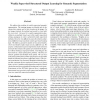105 search results - page 18 / 21 » Fast mesh segmentation using random walks |
157
click to vote
CVPR
2012
IEEE
13 years 2 months ago
2012
IEEE
We address the problem of weakly supervised semantic segmentation. The training images are labeled only by the classes they contain, not by their location in the image. On test im...
106
Voted
CCS
2010
ACM
14 years 10 months ago
2010
ACM
Social network-based Sybil defenses exploit the trust exhibited in social graphs to detect Sybil nodes that disrupt an algorithmic property (i.e., the fast mixing) in these graphs...
110
click to vote
TIP
2010
14 years 6 months ago
2010
In 1964 Edwin H. Land formulated the Retinex theory, the first attempt to simulate and explain how the human visual system perceives color. His theory and an extension, the "r...
BMCBI
2008
14 years 12 months ago
2008
Background: In the adaptive immune system, variable regions of immunoglobulin (IG) are encoded by random recombination of variable (V), diversity (D), and joining (J) gene segment...
114
click to vote
SAC
2008
ACM
14 years 11 months ago
2008
ACM
A number of techniques for generating geometric models of human head and body are in use nowadays. Models of human characters are useful in computer games, virtual reality, and ma...


